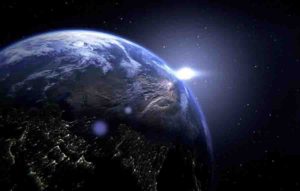
An international study led by Monash University has revealed a new mechanism that may have changed the state of the Earth’s crust some 2.5 billion years ago.
The study, involving researchers from Ruhr-Universität Bochum (Germany) and ETH Zürich (Switzerland) is published in a recent edition of Earth and Planetary Science Letters.
The crust of the modern Earth is in constant slow motion—it moves at about the rate at which our finger nails grow, explains lead study author Dr. Priyadarshi Chowdhury, a Research Fellow at the Monash University School of Earth, Atmosphere and Environment.
“This has resulted in oceans opening (sea-floor spreading) and continents drifting apart through a process, known as ‘plate tectonics,'” he said.
“Some key features that result from the present-day style of plate tectonics were not found in the older rocks, and this is a dilemma.
“Our work shows that the early Earth, sometime prior to 2.5 billion years, operated by a mechanism different than present-day plate tectonics.”
Dr. Chowdhury, is part of the Monash “Pulse of the Earth’ project led by Monash ARC Laureate Fellow Professor Peter Cawood. The project aims to establish the origin and evolution of the continental crust and its role in the long-term development of the Earth system.
The continental crust hosts the resources on which we depend, and its evolution controls the environment in which we live. The crust’s most fundamental feature is that its record (including resources) is episodic in space and time, yet the origin of this periodicity is unresolved.
“The early Earth was hotter than it is today and this affected the strength of the crust and mantle,” said Dr. Chowdhury.
“Our study shows that under these conditions the lower crust peeled off and sank back into the hotter mantle,” he said.
“Importantly, this process explains the characteristics of such ancient rocks, which remained enigmatic.
“We think the ‘peel-back process’ was also the seed for our planet to develop modern plate tectonics.”
The research team used mathematical modelling to map the dynamics of this peel-back process.
They simultaneously tracked the pressure and temperature conditions in different segments of the crust through this process.
This helped them to predict the kinds of igneous and metamorphic rocks that would form, and these predictions were compared with observed rock records on the early Earth.
“These changes set the course of Earth’s evolution that eventually led to its present-day state, which is characterised by continents with thick silicic crust and oceans with thin mafic crust, as well as the presence of an oxygenated atmosphere and the proliferation of life,” Dr. Chowdhury said.
The sparse geological record of the early Earth is a major impediment for unravelling the tectonic setting that triggered these changes.
Numerical modelling fills this gap by allowing geologists to understand the processes that operated at the time and how they provided the stepping-stone for the planet we live on today.
“Our research has been able to identify the tectonic setting that operated billions of years ago that may have set the Earth on a voyage towards the present day planet, which provides the environment for life and the resources on which we depend,” Dr. Chowdhury said.
Reference:
Priyadarshi Chowdhury et al. Peel-back controlled lithospheric convergence explains the secular transitions in Archean metamorphism and magmatism, Earth and Planetary Science Letters (2020). DOI: 10.1016/j.epsl.2020.116224
Note: The above post is reprinted from materials provided by Monash University.










